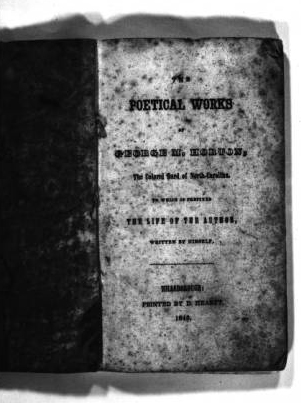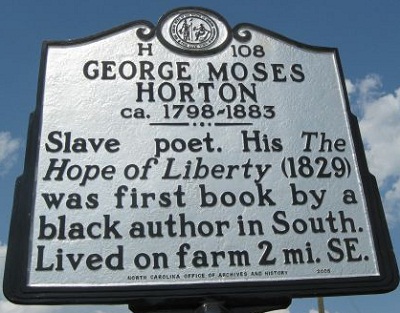Horton, George Moses
by Richard Walser, 1988; Revised by NC Government & Heritage Library, August 2022.
Circa 1797 - 1883
 George Moses Horton, poet, was born enslaved by William Horton in Northampton County. George Moses Horton's mother, his five older half sisters, his younger brother and three sisters were also enslaved by William Horton. As a child, he moved with his enslaver to Chatham County, taught himself to read, and began composing in his head a series of stanzas based on the rhythms in Wesley hymns. In 1814 he was enslaved by William's son James, at whose death in 1843 he was enslaved by James's son Hall.
George Moses Horton, poet, was born enslaved by William Horton in Northampton County. George Moses Horton's mother, his five older half sisters, his younger brother and three sisters were also enslaved by William Horton. As a child, he moved with his enslaver to Chatham County, taught himself to read, and began composing in his head a series of stanzas based on the rhythms in Wesley hymns. In 1814 he was enslaved by William's son James, at whose death in 1843 he was enslaved by James's son Hall.
By the time he was twenty, George Moses Horton had begun visiting the campus of The University of North Carolina eight miles away. There he sold students acrostics on the names of their sweethearts at twenty-five, fifty, and seventy-five cents. For several decades he "bought his time" from his enslavers through the sale of his poems and through wages collected as a campus laborer. Caroline Lee Hentz, novelist and professor's wife, encouraged him; his first printed poem, "Liberty and Slavery," appeared in Mrs. Hentz's hometown Massachusetts newspaper, the Lancaster Gazette, on April 8, 1829. Soon plans were made to purchase his freedom and transport him to Liberia. To raise funds, Horton's The Hope of Liberty, the first book published in the South by a Black man, came later that year from the press of Raleigh's journalist Joseph Gales, but profits were inconsiderable and the plans were dropped. From time to time, Horton won the admiration and support of such men as Governor John Owen, presidents Joseph Caldwell and David L. Swain of The University of North Carolina, and newspapermen William Lloyd Garrison and Horace Greeley.
In 1845 Dennis Heartt of the Hillsborough Recorder brought out The Poetical Works of George M. Horton, The Colored Bard of North-Carolina, To Which Is Prefixed The Life of the Author, Written by Himself. Seldom was Horton  without a manuscript for which he was gathering subscriptions from admiring students and friends. In April 1865 he attached himself to Captain Will H. S. Banks, and thereafter followed Banks's Michigan cavalry unit to Lexington and Concord. Banks sponsored Horton's third book, Naked Genius, published several months later from the press of William B. Smith in Raleigh.
without a manuscript for which he was gathering subscriptions from admiring students and friends. In April 1865 he attached himself to Captain Will H. S. Banks, and thereafter followed Banks's Michigan cavalry unit to Lexington and Concord. Banks sponsored Horton's third book, Naked Genius, published several months later from the press of William B. Smith in Raleigh.
Horton's last years were spent in Philadelphia writing Sunday school stories and working for old North Carolina friends who lived in the city. Details of his death are unrecorded. Sometime in the 1830s, Horton married Martha Snipes, a woman enslaved by Franklin Snipes. George and Martha had two children: a son named Free and a daughter named Rhody, both of whom bore their mother's name.
Horton's poems are traditional in vocabulary and style. Horton's poems for pay -- mostly those written for students at UNC -- are very different than his poems discussing rural life and slavery. His poetic protests of his status are the first ever written by a slave in America.
Educator Resources:
George Moses Horton Lesson Plan from the State Archives of North Carolina
Grade 8: George Moses Horton. North Carolina Civic Education Consortium. http://civics.sites.unc.edu/files/2012/05/GeorgeMosesHorton.pdf
References:
Page, Amanda. "George Moses Horton" in The North Carolina Roots of African American Literature: An Anthology (William L. Andrews, editor). The University of North Carolina Press, 2006: 46.
Farrison, W. Edward. "George Moses Horton: Poet for Freedom," CLA Journal (March 1971)
Walser, Richard.The Black Poet (1966).
Additional Resources:
The George Moses Horton Project. http://chathamarts.org/horton/
Resources on George Moses Horton at LEARN NC. http://www.learnnc.org/search?area=&phrase=George+Moses+Horton
"Who was George Moses Horton?" State Archives of North Carolina. http://exhibits.archives.ncdcr.gov/educationalresources/georgehorton.html (accessed November 1, 2013).
Slavery and the Making of the University. University of North Carolina at Chapel Hill. http://www.lib.unc.edu/mss/exhibits/slavery/horton.html
"George Moses Horton" at the North Carolina Highway Historical Markers Project. https://ncmarkers.com/Markers.aspx?MarkerId=H-108
Poems by George Moses Horton at Poets.org. http://www.poets.org/viewmedia.php/prmMID/16645
Harris, Trudier. “African American Protest Poetry.” Freedom’s Story, TeacherServe. National Humanities Center. http://nationalhumanitiescenter.org/tserve/freedom/1917beyond/essays/aaprotestpoetry.htm (accessed March 15, 2012).
Horton, George Moses. 1837. Poems by a slave. 2nd ed. Philadelphia : [s.n.].
1999. George Moses Horton: Documentary Resources Available at the University of North Carolina at Chapel Hill. http://www.lib.unc.edu/mss/exhibits/horton/index.html
Sherman, Joan R., ed. 1997. The black bard of North Carolina: George Moses Horton and his poetry. Chapel Hill: The University of North Carolina Press.
"George Horton, The Slave Poet." The University Magazine (University of North Carolina) 20/7, no. 4 (May 1888). 229-232. https://archive.org/stream/northcarolinauni18871888#page/228/mode/2up (accessed March 14, 2014).
Image Credit:
Work by George Moses Horton. Image courtesy of Digital North Carolina Collection Photographic Archives, UNC Libraries. Available from http://dc.lib.unc.edu/cdm/singleitem/collection/dig_nccpa/id/2829/rec/82 (accessed June 17, 2013).
North Carolina Highway Historical Marker Program. "Marker H-108." Photograph. Raleigh, 1999. https://www.ncdcr.gov/about/history/division-historical-resources/nc-highway-historical-marker-program/Markers.aspx?sp=Markers&k=Markers&sv=H-108.(accessed March 15, 2012).
1 January 1988 | Walser, Richard